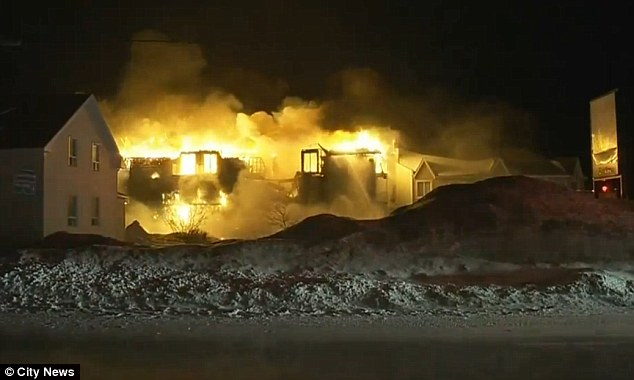Thursday
With Donald Trump’s election, futurist fiction is coming back into fashion, with such classics as George Orwell’s 1984 and Margaret Atwood’s Handmaid’s Tale climbing onto bestseller lists. Atwood at the moment is making a late career out of dystopias, and Trump’s State of the Union address Tuesday brought one of them to mind.
“Torch the Dusties” appears in a collection of nine short stories entitled Stone Mattress (2015). Before I tell you what it’s about, see if you can interpret the title from my telling you which aspect of Trump’s agenda made me think of it.
Here’s the Atlantic’s Ronald Brownstein explaining where Trumpist policy appears to be heading:
“As the nation went through this very rapid demographic change, the question has been [whether] older white Americans would essentially withdraw from the public sphere and not fund a new generation who did not look like their kids,” said Simon Rosenberg, president of NDN, a Democratic advocacy group. “You are going to see that basic dynamic play out in a very significant way under Trump. What Trump is doing is creating a wall around older white Americans: he is being an isolationist both within the country and without. He is trying to create walls between older white Americans and the new Americans who surround them.”
It’s not only Trump. Brownstein says the American economy has been moving this way for a while:
The repeated budget showdowns between Congressional Republicans and former President Obama tilted Washington’s fiscal priorities even further away from young people by largely exempting entitlement programs from reductions while imposing severe caps on discretionary spending. Though Congress and Obama repeatedly agreed to loosen the constraints, the weight of those caps has pushed down domestic discretionary spending to about 3 percent of gross domestic product, near its nadir since Washington began keeping such records in the early 1960s.
The Urban Institute has calculated that the federal government now spends about $6 per capita on seniors for every $1 it spends on kids. (Even including state and local spending, where most education dollars are committed, governments at all level spend about $2.3 per capita on seniors for every $1 they spend on kids.) Looking forward, the institute projects that programs aimed at kids will receive only 2 percent of the anticipated rise in federal spending over the next decade-and by the end of that period, in 2026, the portions of Social Security, Medicare and Medicaid that benefit adults will account for almost exactly half of the entire federal budget.
Atwood’s “dusties,” as you may have figured out by now, are the elderly. Envying their comfortable life, the stressed younger generation is becoming increasingly resentful. Only gradually as the story unfolds do we discover that they are torching retirement homes with the old people still inside them. An elderly patient explains to the story’s protagonist what’s up:
“What else did you learn?” Wilma asks. All around them is the clanking of spoons on china, the murmur of thinning voices, an insect vibration.
“They say it’s their turn,” says Tobias. “That’s why they put Our Turn on the signs.”
“Oh,” says Wilma. Lights dawns. Atern. Our Turn. She’d misheard. “Their turn at what?”
“At life, they say. I heard one of them on the television news; naturally they’re being interviewed all over the place. They say we’ve had our turn, those our age; they say we messed it up. Killing the planet with our own greed and so forth.”
“They have a point there,” says Wilma. “We did mess it up. Not on purpose, though.”
And later:
“What do they want from us?” she asks, trying not to sound peevish. “Those people with the signs. For heaven’s sakes. It’s not as if we can do anything.”
“They say they want us to make room. They want us to move over. Some of the signs say that: Move Over.”
“That means die, I suppose,” says Wilma. “Are there any rolls today?” Sometimes there are the most delicious Parker House rolls, fresh from the oven.
Atwood’s genius lies in the matter-of-fact way that her dystopias unfold. Life in the retirement center is so out of touch with the rest of the world that the crisis catches the residents unawares. It’s not unlike a number of the slow-burning crises that threaten us these days, most notably climate change.
Reality cannot be forestalled forever, and Wilma and Tobias, having had the foresight to escape through the basement, watch as activists block all the entrances and then torch the center and all of its residents. We are left wondering whether such a fate threatens any group–or for that matter, any nation–that retreats behind protective walls as it hogs a disproportionate percentage of available resources.
Further thought: I’ve been thinking about how angry certain young Bernie supporters continue to be, finding ways to tag even a progressive like new Democrat Central Committee chair Tom Perez as an establishment Democrat. And of course there is the burn-it-all-down support for Trump from many lower income voters on the right. If Atwood is correct, then this anger is only going to become more fiery as wealth is redistributed upward. Remember that our best authors are in touch with deep currents and that in science fiction, as Ursula LeGuin once noted, the future is a metaphor for the present.


